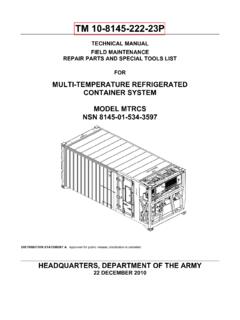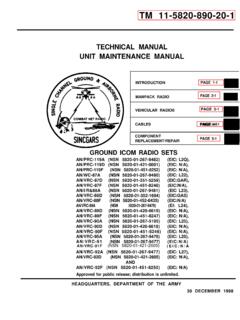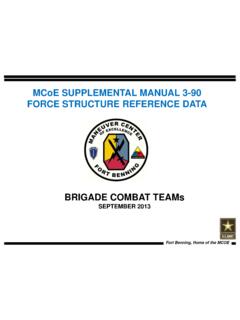Transcription of POCKET GUIDE TM 11-5820-890-10-6 SINCGARS ICOM …
1 POCKET GUIDE TM 11-5820-890-10-6 . SINCGARS ICOM GROUND RADIOS. Used with Automated Net Control Device (ANCD);. Precision Lightweight GPS Receiver (PLGR);. Handheld Remote Control Radio Device (HRCRD). OPERATOR'S. POCKET GUIDE . RADIO SETS. MANPACK RADIO. (AN/PRC-119A/D/F). (NSN: N/A) (EIC: N/A). VEHICULAR RADIOS. (AN/VRC-87A/D/F THRU. AN/VRC-92A/D/F). (NSN: N/A) (EIC: N/A). Approved for public release; distribution is unlimited. Headquarters, Department of the Army 1 December 1998. POCKET GUIDE TM 11-5820-890-10-6 . LITHIUM BATTERY WARNINGS. Your manpack radio uses a lithium battery as the main power source. All SINCGARS . radios use a lithium battery for the HUB, and the ANCD uses three 3-volt lithium batteries for power. Lithium batteries contain pressurized toxic, sulfur dioxide gas. Batteries can explode; treat them with CARE! For safety's sake, follow these rules when handling lithium batteries: Do NOT ABUSE LITHIUM BATTERIES IN ANY WAY.
2 Do NOT HEAT, SHORT CIRCUIT, CRUSH, PUNCTURE, OR CUT THEM. Do NOT USE ANY LITHIUM BATTERY SHOWING SIGNS OF DAMAGE. Do NOT TEST THEM FOR STATE OF CHARGE (MAINTAINER TASK ONLY). Do NOT ATTEMPT TO RECHARGE LITHIUM BATTERIES. Do NOT PLACE THEM IN ORDINARY TRASH. TURN IN USED BATTERIES TO UNIT. SUPPLY, OR WHEN OPERATIONAL FOLLOW UNIT SOP REGARDING. DISPOSAL. Do NOT USE A HALON-TYPE FIRE EXTINGUISHER ON A LITHIUM FIRE IN- CASE OF FIRE, DOUSE WATER, USE CO2 OR CLASS D EXTINGUISHER. Do NOT STORE BATTERIES IN UNUSED EQUIPMENT. Do NOT STORE LITHIUM BATTERIES WITH OTHER HAZARDOUS MATERIALS. Do NOT STORE LITHIUM BATTERIES NEAR FLAME OR HEAT. If battery compartment becomes hot to touch, if it hisses or makes a burping sound, or if you smell an irritating gas: TURN OFF EQUIPMENT. LET EQUIPMENT COOL FOR AT LEAST AN HOUR. AFTER EQUIPMENT IS COOL REMOVE BATTERY/BATTERIES.
3 INSTALL NEW BATTERY/BATTERIES, RESUME OPERATING. If you experience a safety hazard or incident, notify your unit Safety Officer; file Form 368. (Product Quality Deficiency Report), and notify CECOM Safety Office, Ft. Monmouth, NJ. (DSN 995-3112). POCKET GUIDE *TM 11-5820-890-10-6 . TABLE OF CONTENTS. SUBJECT PAGE. SECTION I: INTRODUCTION. 1. 1. Designations .. 1. Auxiliary Items .. 1. References .. 2. Abbreviations .. 2. SECTION II: GRAPHICS. RT-1523/A/B Keypads .. 3. RT-1523C/D Keypads .. 4. RT-1523E 5. RT-1523E Front 6. ANCD Front View .. 7. ANCD 7. 8. SECTION III: PRIMARY OPERATOR/PREPARATION TASKS. RT-1523E (ASIP) Preparation 1. Select RT Preparation Settings from 9. Summary of Primary Operator 10. 1. Load SC Frequencies into SINCGARS 11. 2. Load COMSEC/FH Data/Sync Time Using 12. 3. Perform Hot Start Net 13. 4. Perform Passive Late Net 13. 5.
4 Obtain SOI Information From 14. _____. * Supersedes TM 11-5820-890-10-6 , dated 1 January 1998. i POCKET GUIDE TM 11-5820-890-10-6 . SECTION IV: SPECIAL OPERATOR TASKS. SUBJECT PAGE. Summary of Special Operator Tasks .. 19. 1. Transfer COMSEC/FH Data/Sync Time from ANCD to 21. 2. Transfer Full or QREF SOI from ANCD to 22. 3. Perform Cold Start Net 25. 4. Receive Net Update ERF from 26. 5. Perform CUE and ERF Late Net 27. 6. Conduct RXMT Operations .. 28. 7. Send an ERF as Part of RXMT 30. 8. Change Net 31. 9. Use SIP/ASIP RT as an 32. 10. Use SIP/ASIP RT to Send Data Via RS-232 33. SECTION V: PLGR TASKS. 1. Obtain Date and GPS Zulu Time from 34. 2. Manually Load PLGR Date and Zulu Time Into 35. 3. Load PLGR Date and Zulu Time Into 37. 4. Load Key Into PLGR from 39. SECTION VI: HRCRD OPERATIONS. General .. 41. Radio Control .. 41. Volume .. 41. Back Lights.
5 41. Cabling .. 41. RT Keypad .. 41. Vehicular 42. SECTION VII: PMCS. 1. SINCGARS 43. 2. 47. ii POCKET GUIDE TM 11-5820-890-10-6 . SECTION I. INTRODUCTION. PURPOSE: To provide operators of SINCGARS manpack and vehicular RT's including SIP/ASIP version radios with quick reference memory joggers to assist in task performance during training and operations. The primary goal is to prevent radio operators from having to memorize any tasks, steps, or other procedures. Through reference to this POCKET GUIDE , the properly trained SIP operator should be able to perform, without assistance, all primary operator tasks, and those special tasks for which especially trained. SCOPE: This POCKET GUIDE covers the five primary operator tasks and ten special tasks. Tasks are presented in flowchart format, with minimum essential explanation. In addition to normal SINCGARS .
6 Tasks, SIP/ASIP specific, Special Operator's 9-10 tasks, this GUIDE includes essential graphics, SINCGARS PMCS, Handheld Remote Control Radio Device (HRCRD) operations, and selected tasks pertaining to the Precision Lightweight GPS Receiver (PLGR). Operators are to refer to the SINCGARS Operator's Manual, TM. 11-5820-890-10-8, and other appropriate TM's, when additional information is needed. DESIGNATIONS: SlP radio configurations carry a "D" designation. Unit authorized SIP radio configurations will receive only SIP components: RT-1. 523C/D and AM-7239C/D. ASIP radio configurations carry a "F". designation. Unit authorized ASIP radio configurations will receive only ASIP components RT-1523E and AM-7239E. Other SINCGARS radios will carry a "A" designation. AUXILIARY ITEMS The Automated Net Control Device (ANCD) and ITEMS: PLGR are considered to be authorized and employed in conjunction with SINCGARS .
7 1. POCKET GUIDE TM 11-5820-890-10-6 . REFERENCES: TM 1-5810-394-14&P, ANCD Opr and Unit Maint TM 11-5810-890-10-7, NCS POCKET GUIDE TM 11-5820-890-10-8, SINCGARS Opr's Manual TM 11-5825-291-13, PLGR Opns and Maint ABBREVIATIONS: ANCD .. Automated Net Control Device BPS ..Bits Per Second CID ..Combat Identification Security Text Data Transfer Device Enhanced Data Mode External Frequency Hopping Positioning System Remote Control Radio Device Communications Security INC ..Internet Controller KEK ..Key Encryption Key Data Entry or Enhanced Data Mode Packet Data Mode Lightweight GPS Receiver Text Remote Control Unit RCU (RT) ..SIP used as an RCU. SA ..Situational Awareness System Improvement Program TEK .. Traffic Encryption Key Time Figure of Merit Amplifier Adapter 2. POCKET GUIDE TM 11-5820-890-10-6 . SECTION II. GRAPHICS. RT-1523/A/B FRONT PANEL. RT-1523/A/B KEYBOARD.
8 3. POCKET GUIDE TM 11-5820-890-10-6 . RT-1523C/D (SIP) FRONT PANEL. RT-1523C/D (SIP) KEYBOARD. NOTES: 1] Four keys of SIP keypad are redesignated. 2] SA and CID keys are not used. 3] RCU key enables use of SIP RT as an RCU. 4] GPS key enables loading of GPS time. 4. POCKET GUIDE TM 11-5820-890-10-6 . RT-1523E (ASIP) KEYBOARD. NOTES: 1] Six keys of ASIP keypad are redesignated. 2] SA, CID and GPS keys are not used. 3] RCU key enables use of ASIP RT as an RCU. 4] MENU key scrolls through MENU selections. 5] FREQ/Backlight key controls backlight brightness. RT must be in SQ ON and CHG scrolls level. 5. POCKET GUIDE TM 11-5820-890-10-6 . RT-1523E (ASIP) FRONT PANEL. 6. POCKET GUIDE TM 11-5820-890-10-6 . FRONT VIEW >. REAR VIEW >. (cover open). AUTOMATED NET CONTROL DEVICE, AN/CYZ-10. 7. POCKET GUIDE TM 11-5820-890-10-6 . PRECISION LIGHTWEIGHT GPS RECEIVER (PLGR).
9 8. POCKET GUIDE TM 11-5820-890-10-6 . SECTION III PRIMARY OPERATOR/PREPARATION TASKS. PREPARATION TASK 1: Select RT Preparation Settings from MENU. SUBTASKS ACTION RESULTS. a. Set RT Volume (1) Press MENU Press Menu to display Vol (2) Press Digit (1-9) level for Vol Setting (0) for Display reads WHSP if 0. Whisper Mode selected b. Set RT Channel (1) Press MENU (until Display reads (1-6), (Q). CHAN) for CUE, (M) for Manual (2) Press Digit (1-6). for Channel desired (0) for MAN 17) for CUE. c. Set RT Power (1) Press MENU (until Display reads (LO, M, HI, PWR) PA). (2) Press CHG for desired PRW setting d. Set RT Mode (1) Press MENU (until Display reads (SC, FH, MODE FHM. (2) Press CHG for desired MODE. e. Set COMSEC (1) Press MENU (until Display reads (PT, CT, TD, CMSC) RV). (2) Press CHG for desired CMSC setting f. Set Backlight (1) Place RT in SQ Backlight lights (4 settings ON (2) Press Low to High, then OFF).)
10 FREQ/Backlight (3) Press CHG until desired setting DEFAULT SETTINGS ARE VOL (5), CHAN (1), PWR (LO), MODE (FH), COMSEC (CT). 9. POCKET GUIDE TM 11-5820-890-10-6 . SECTION III. PRIMARY OPERATOR TASKS. PRIMARY TASK 1: Load SC Frequencies into SINCGARS RT: Required for Cold Start Net Opening, CUE and ERF method of late net entry, single channel communications, and SC. frequency updates. PRIMARY TASK 2: Load COMSEC/FH Data/Sync Time Using ANCD: Required for Hot Start Net Opening, Cold Startnet opening (less sync time), and COMSEC/FH Data updates (less sync time). PRIMARY TASK 3: Perform Hot Start Net Opening: Required when net has been down and is now to become operational at a prescribed time; and may be used when an individual operator has been out of the net for any reason and wishes to re-enter the net without resorting to CUE and ERF. PRIMARY TASK 4: Perform, Passive Late Net Entry: Required when RT sync time becomes more than 4 seconds but less than one minute off from net sync time; enables individual operator to re-enter net without action on the part of the NCS.





